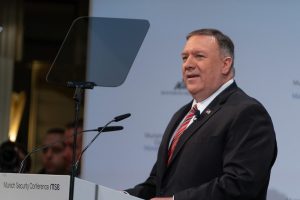When Secretary of State Mike Pompeo addressed the Munich Security Conference last month and warned about the rise of China, he encountered considerable European skepticism. Yet China was the most mentioned country at the annual event whose theme this year was “Westlessness” – a general unease about the decline of the West. While many Europeans understood their need to develop common policies toward China, there was an exaggerated mood of Western decline.
The theme is not new. Oswald Spengler wrote his famous work The Decline of the West in the aftermath of World War I. During the Cold War, American pundits and politicians went through cycles of belief in declinism. With the end of the Cold War, however, many believed the West had prevailed. In his 1992 book The End of History and the Last Man, Francis Fukuyama wrote that humanity had reached “the end-point of mankind’s ideological evolution and the universalization of Western liberal democracy as the final form of human government.” A few years later, Samuel Huntington issued a gloomier prognosis in The Clash of Civilizations and the Remaking of World Order that “the rise of China and the increasing assertiveness of this ‘biggest player in the history of man’ will place tremendous stress on international stability in the early twenty-first century.”
Western civilization did not exist in full flower until 1500, and before 1800 Asia (including India and Japan as well as China) was home to more than half the world’s population and world economy. By 1900, however, while Asia still represented more than half the world’s population it was only 20 per cent of the world economy. The industrial revolution in Europe and North America and domination of the seas had made Europe the center of the global balance of power until it tore itself apart in World War I.
After U.S. entry tipped the outcome of the war, we became crucial to the global balance of power, but we retreated into isolationism and the 1930s was a disastrous decade. Following World War II, Franklin Roosevelt, Harry Truman and Dwight Eisenhower avoided the mistakes of isolationism and created the institutions of a Western liberal order. Now some realists believe the rise of China portends a conflict that will tear the world apart much as Europe suffered in 1914. But these gloomy projections rest on exaggerations of China’s power and Western weakness. China’s economy is about two-thirds that of the US, and an even smaller fraction if Europe, Japan, Australia and other Western allies are included.
China is a country of both strengths and weaknesses. The United States has several advantages. One is geography. We are bordered by oceans and friendly neighbors, while China has borders with fourteen countries and territorial disputes with India, Japan, and Vietnam. Energy is another advantage. The shale revolution has transformed the U.S. from an energy importer to exporter, while China depends on imports that pass through the Persian Gulf and the Indian Ocean where we have naval supremacy. America also has demographic advantages. Over the next decade and a half, our workforce is likely to increase by 5 percent while China’s will decline by 9 percent. China will soon lose its first-place population rank to India, and its working age population already peaked in 2015.
America has been at the forefront in the development of key technologies (bio, nano, information), and Western research universities dominate higher education. In a 2017 ranking by Shanghai Jiaotong University, all the top twenty global universities were Western; none Chinese. China is investing heavily in research and development, competes well in some fields now, including artificial intelligence, and its technological progress is no longer based solely on imitation. We have to take China’s technology challenge seriously and should not become vulnerable to firms like Huawei, but a successful Western response will also depend upon investing in research at home.
In short, the United States and the West still hold high cards, but hysteria could cause us to play our cards poorly. Discarding our aces of alliances and international institutions would be a serious mistake. If the U.S. maintains its alliance with Japan, China cannot push the U.S. out the Western Pacific. Another mistake would be to try to cut off all immigration. A few years ago, when I asked former Singapore Prime Minister Lee Kuan Yew why he did not think China would surpass the United States as a global power any time soon, he cited the ability of America to draw upon the talents of the whole world and recombine them in diversity and creativity that was not possible for China’s ethnic Han nationalism. If populism leads the West to discard its high cards of alliances and openness, Lee could be wrong.
In 2017, Bill Emmott wrote in The Fate of the West “Yes the barbarians are at the West’s gates. Certainly China’s pressure to dominate its neighborhood and be treated as an equal partner to the U.S. is hard to deal with.” But a successful response rests on “allies, friendships and legitimacy – the greatest assets the West has.” The danger of “Westlessness” comes more from our loss of confidence and the rise of populist isolationism at home than from the rise of China abroad.
Joseph S. Nye, Jr. is a professor at Harvard and author of Do Morals Matter? Presidents and Foreign Policy from FDR to Trump (Oxford University Press, 2020).

































